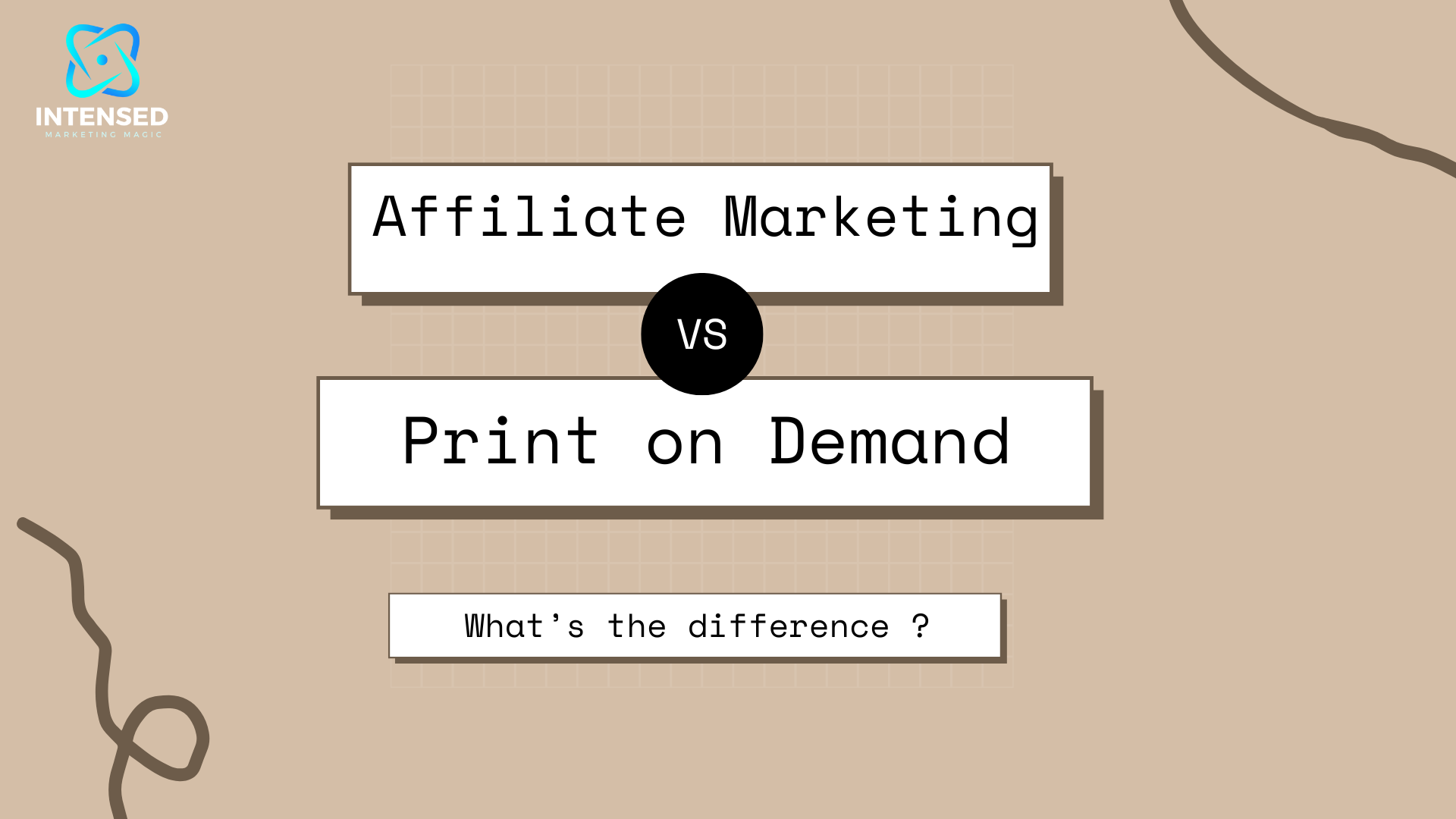In the world of online business, two popular models have emerged as attractive options for entrepreneurs: affiliate marketing and print on demand. Both offer the potential for generating income with low startup costs, but they differ in their approach and execution.
Understanding the key differences between these two business models is crucial for anyone looking to start their own online venture. In this comprehensive guide, we’ll dive deep into the pros and cons of affiliate marketing and print on demand, helping you make an informed decision about which path to pursue.
- What is Affiliate Marketing?
- What is Print on Demand?
- Affiliate Marketing vs Print on Demand: Head-to-Head Comparison
- Which is Better for Beginners: Affiliate Marketing or Print on Demand?
- Best Affiliate Marketing Programs and Networks
- Best Print on Demand Platforms and Services
- Case Studies and Success Stories
- Conclusion
- Frequently Asked Questions (FAQ)
What is Affiliate Marketing?
Affiliate marketing is a performance-based marketing model where you, as an affiliate, promote products or services offered by another company (the merchant). When a customer clicks on your unique affiliate link and makes a purchase, you earn a commission.
The merchant handles the product creation, inventory management, shipping, and customer support, while you focus on driving traffic and sales through your marketing efforts.
Pros of Affiliate Marketing
- Low startup costs: One of the biggest advantages of affiliate marketing is the minimal upfront investment required. You don’t need to create your own products or manage inventory, which significantly reduces your initial expenses.
- Potential for passive income: Once you have a well-established affiliate website or blog with a steady stream of traffic, you can earn commissions even while you sleep. This passive income potential is a major draw for many affiliate marketers.
- No product or customer support responsibilities: As an affiliate, you don’t have to worry about product development, inventory management, shipping, or customer support. These tasks are handled by the merchant, allowing you to focus solely on marketing and driving sales.
Cons of Affiliate Marketing
- Limited control over products and pricing: As an affiliate, you have no say in the products you promote or their prices. If the merchant makes changes to their offerings or pricing structure, it can directly impact your earnings.
- Dependence on merchant’s reputation and performance: Your success as an affiliate is closely tied to the reputation and performance of the merchants you promote. If a merchant provides poor quality products or services, it can reflect negatively on your own brand.
- Unpredictable and potentially low commissions: Commission rates can vary widely between affiliate programs, and some may offer relatively low percentages. Additionally, if the products you promote have low price points, your earnings per sale may be minimal.

What is Print on Demand?
Print on demand (POD) is a business model where you create custom designs for various products, such as t-shirts, mugs, or phone cases, and sell them online without holding any inventory.
When a customer places an order, the POD service provider prints the product with your design and ships it directly to the customer. You earn the difference between the retail price you set and the base cost charged by the POD platform.
Pros of Print on Demand
- Low startup costs: Like affiliate marketing, starting a print on demand business requires minimal upfront investment. You don’t need to purchase inventory or equipment, as the POD service provider handles production and shipping.
- Ability to create and sell custom products: With print on demand, you have the freedom to create unique designs and offer a wide range of customized products to your target audience. This allows you to build a brand that stands out from the competition.
- No inventory or shipping hassles: Since the POD service provider handles all aspects of production and fulfillment, you don’t have to worry about managing inventory or dealing with shipping logistics. This frees up your time to focus on design, marketing, and growing your business.
Cons of Print on Demand
- Lower profit margins: Compared to traditional product sales, print on demand businesses often have lower profit margins. This is because you’re paying the POD service provider for production and fulfillment, which cuts into your earnings per sale.
- Reliance on POD service providers: Your print on demand business is heavily dependent on the quality, reliability, and pricing of the POD platform you choose. If they experience production delays, quality issues, or raise their prices, it can directly impact your business.
- Potential quality control challenges: Since you’re not directly involved in the production process, there’s a risk of inconsistencies in product quality. It’s important to partner with reputable POD providers and regularly order samples to ensure your products meet your standards.

Affiliate Marketing vs Print on Demand: Head-to-Head Comparison
Now that we’ve covered the basics of affiliate marketing and print on demand, let’s compare these two business models across several key factors:
Startup Costs
Both affiliate marketing and print on demand have relatively low startup costs compared to traditional brick-and-mortar businesses. However, there are some differences to consider:
- Affiliate marketing: The main expenses include website hosting, domain registration, and any tools or software you use for content creation and SEO. You may also invest in paid advertising to drive traffic to your affiliate links.
- Print on demand: In addition to website hosting and domain costs, you may need to invest in design software (if creating your own designs) or pay for design services. Some POD platforms also charge small listing fees or monthly subscriptions.
Overall, both models have low barriers to entry, making them attractive options for entrepreneurs on a budget.

Earning Potential
The earning potential for affiliate marketing and print on demand depends on several factors, such as your niche, target audience, marketing skills, and the products you promote or sell.
- Affiliate marketing: Your income is determined by the commission rates offered by the merchants you promote, the price points of the products, and the volume of sales you generate. According to a survey by Awin, the average affiliate marketer earns $12,000 per year, with the top 1% earning over $71,000 annually.
- Print on demand: Your earnings are based on the profit margin between the retail price you set and the base cost charged by the POD platform. The global print on demand market is expected to reach $39.8 billion by 2030, growing at a CAGR of 33.8% from 2022 to 2030. However, individual success varies widely depending on factors such as design quality, niche popularity, and marketing effectiveness.
Both models offer the potential for significant income, but success requires consistent effort, strategic planning, and continuous optimization.

Skills and Tasks Required
Running an affiliate marketing or print on demand business involves a range of skills and tasks:
- Affiliate marketing: Key skills include content creation (writing, video, etc.), SEO, social media marketing, email marketing, and data analysis. Tasks involve researching products, creating content to promote affiliate offers, driving traffic to your affiliate links, and optimizing your campaigns based on performance data.
- Print on demand: Essential skills include graphic design (if creating your own designs), product research, niche selection, and marketing. Tasks include designing or curating products, setting up your online store, optimizing product listings, processing orders, and promoting your products through various channels.
Both models require a strong understanding of digital marketing, e-commerce best practices, and the ability to adapt to changing market trends.
Risks and Challenges
No business model is without risks and challenges. Here are some potential drawbacks to consider for affiliate marketing and print on demand:
- Affiliate marketing: The main risks include reliance on third-party merchants (who may change their terms or discontinue programs), competition from other affiliates, and the potential for affiliate links to become outdated or broken. Additionally, generating consistent traffic and sales can be challenging, especially in highly competitive niches.
- Print on demand: Risks include potential quality control issues, shipping delays, and the possibility of your designs being copied or infringed upon. You’ll also need to continuously create new designs to keep your store fresh and appealing to customers. Marketing and driving traffic to your store can be challenging, particularly in saturated niches.
Understanding and mitigating these risks is crucial for long-term success in either business model.

Which is Better for Beginners: Affiliate Marketing or Print on Demand?
The choice between affiliate marketing and print on demand ultimately depends on your individual goals, skills, and preferences. Here are some factors to consider:
- Skills: If you have a knack for writing, content creation, and digital marketing, affiliate marketing might be a good fit. If you have graphic design skills or a strong eye for curating products, print on demand could be a better choice.
- Niche: Consider your interests and expertise when choosing a niche. For affiliate marketing, select a niche with products that align with your audience’s needs and offer attractive commission rates. For print on demand, choose a niche with a strong demand for customized products and room for creativity.
- Time investment: Both models require consistent effort, but affiliate marketing may involve more time spent on content creation and SEO, while print on demand may require more time for design and product management.
- Branding: If building your own brand is a priority, print on demand offers more opportunities to create a unique brand identity through custom products. Affiliate marketing primarily involves promoting other brands, although you can still establish a strong personal brand through your content and marketing efforts.
Ultimately, both affiliate marketing and print on demand can be suitable for beginners, and the best choice depends on your individual circumstances and preferences.

Best Affiliate Marketing Programs and Networks
If you’re considering affiliate marketing, here are some top programs and networks to explore:
- Amazon Associates: As one of the largest e-commerce platforms, Amazon offers a wide range of products to promote and competitive commission rates.
- ClickBank: This network focuses on digital products, such as e-books, courses, and software, with commission rates often ranging from 50-75%.
- ShareASale: With over 4,000 merchants across various niches, ShareASale offers a diverse selection of affiliate programs to join.
- CJ Affiliate (Commission Junction): This well-established network features a wide range of well-known brands and offers, making it a popular choice among affiliate marketers.
- Rakuten Marketing: Formerly known as LinkShare, Rakuten Marketing provides access to a large number of affiliate programs across multiple verticals.
When selecting affiliate programs, consider factors such as commission rates, cookie duration, product quality, and merchant reputation to maximize your earning potential.
Best Print on Demand Platforms and Services
If you’re interested in starting a print on demand business, here are some top platforms and services to consider:
- Printful: With a wide range of products, integrations with popular e-commerce platforms, and a user-friendly mockup generator, Printful is a popular choice for POD entrepreneurs.
- Printify: This platform offers a large selection of products, competitive pricing, and integrations with major e-commerce platforms like Shopify and WooCommerce.
- Redbubble: Redbubble is a marketplace that allows artists to upload their designs and sell them on a variety of products. It’s a great option for those looking to start selling quickly without setting up their own store.
- Teespring: Teespring offers a range of products and a simple design interface, making it easy to create and sell custom products. They also provide tools for marketing and promoting your products.
- Society6: Similar to Redbubble, Society6 is a marketplace where artists can sell their designs on a variety of products. They offer a curated selection of high-quality products and handle all aspects of production and shipping.
When choosing a print on demand platform, consider factors such as product quality, pricing, shipping options, and integrations with your preferred e-commerce platform.
Case Studies and Success Stories
To provide inspiration and insights, let’s look at some real-life examples of successful affiliate marketers and print on demand entrepreneurs:
- Pat Flynn – Smart Passive Income: Pat Flynn is a well-known affiliate marketer who has built a successful business by promoting products and services in the online business and personal development niches. Through his blog posts, podcast, and courses, he educates others on how to build passive income streams through affiliate marketing and other strategies.
- Zach Inman – Affiliate Marketer: Zach Inman is an affiliate marketer who specializes in the outdoor niche. He has built a successful affiliate website, OutdoorGearLab.com, which reviews and recommends outdoor gear and equipment. By providing valuable content and leveraging SEO, Zach has generated significant income through affiliate commissions.
- Greg Gifford – Teelaunch: Greg Gifford is a print on demand entrepreneur who has built a successful business using the Teelaunch platform. He creates designs for a variety of niches, including pets, hobbies, and pop culture references. By leveraging Facebook ads and influencer marketing, Greg has grown his POD business to generate a substantial income.
- Ryan Hogue – Passive Income with POD: Ryan Hogue is a print on demand entrepreneur who shares his experiences and strategies through his blog and YouTube channel. He has built multiple successful POD stores in various niches and teaches others how to research profitable niches, create designs, and market their products effectively.
These success stories demonstrate that with dedication, strategic planning, and continuous learning, it’s possible to build a thriving business in both affiliate marketing and print on demand.

Conclusion
In this comprehensive guide, we’ve explored the key differences between affiliate marketing and print on demand, two popular online business models. Both offer the potential for generating income with low startup costs, but they differ in their approach, skills required, and day-to-day tasks.
Affiliate marketing involves promoting products or services offered by other companies and earning commissions on sales generated through your unique affiliate links. It requires skills in content creation, SEO, and digital marketing, and success depends on driving targeted traffic and optimizing your campaigns.
Print on demand, on the other hand, involves creating custom designs for various products and selling them online without holding inventory. When a customer places an order, the POD service provider handles production and shipping. Success in print on demand relies on creating appealing designs, selecting profitable niches, and effectively marketing your products.
Ultimately, the choice between affiliate marketing and print on demand depends on your individual goals, skills, and preferences. Both models offer the potential for significant income, but success requires consistent effort, strategic planning, and continuous optimization.
Whether you choose to pursue affiliate marketing, print on demand, or a combination of both, remember that building a successful online business takes time and dedication. Stay focused on providing value to your target audience, continuously learning and adapting to industry trends, and never giving up on your entrepreneurial dreams.
Frequently Asked Questions (FAQ)
Is affiliate marketing still profitable in 2024?
Yes, affiliate marketing remains a profitable business model in 2024. As e-commerce continues to grow, there are plenty of opportunities to promote products and services across various niches. However, success requires staying up-to-date with industry trends, providing value to your audience, and continuously optimizing your marketing strategies.
How much money do I need to start a print on demand business?
You can start a print on demand business with a relatively small investment. Costs typically include website hosting, domain registration, and any design software or services you need. Some POD platforms also charge small listing fees or monthly subscriptions. On average, you can expect to invest a few hundred dollars to get started.
Do I need a website for affiliate marketing?
While it’s possible to promote affiliate links through social media and other channels, having your own website is highly recommended. A website allows you to build trust with your audience, create targeted content, and have greater control over your affiliate marketing efforts. It also provides a central hub for your business and can help establish your brand.
How do I find profitable niches for print on demand?
To find profitable niches for print on demand, consider the following strategies:
1. Research trending topics and popular niches on social media and marketplaces like Etsy and Amazon.
2. Use keyword research tools to identify search terms with high demand and low competition.
3. Analyze successful print on demand stores to see what niches and designs are selling well.
4. Consider your own interests and hobbies, as passion can drive success in a niche.
How long does it take to start making money with affiliate marketing?
The timeline for generating income with affiliate marketing varies depending on factors such as your niche, competition, marketing strategies, and the quality of your content. Some affiliates start earning commissions within a few months, while others may take longer to gain traction. Consistency and persistence are key to building a successful affiliate marketing business.
Can I use multiple print on demand platforms?
Yes, you can use multiple print on demand platforms to expand your product offerings and reach a wider audience. However, keep in mind that managing multiple platforms can be time-consuming, and you’ll need to ensure consistent branding and quality across all your products.
How do I promote my affiliate links?
There are several effective ways to promote your affiliate links:
1. Create valuable content (blog posts, videos, reviews) that naturally incorporates your affiliate links.
2. Share your affiliate links on social media platforms where your target audience is active.
3. Build an email list and promote affiliate offers to your subscribers.
4. Invest in paid advertising, such as Google AdWords or Facebook Ads, to drive targeted traffic to your affiliate links.
What are the best marketing strategies for print on demand?
Some of the most effective marketing strategies for print on demand include:
1. Leveraging social media platforms to showcase your products and engage with your target audience.
2. Collaborating with influencers in your niche to promote your products to their followers.
3. Using paid advertising, such as Facebook Ads or Instagram Ads, to target potential customers.
4. Optimizing your product listings for search engines to improve organic visibility.
5. Building an email list and promoting your products to subscribers through newsletters and targeted campaigns.
How do I handle taxes for my affiliate marketing or print on demand business?
As a business owner, it’s essential to keep accurate records of your income and expenses for tax purposes. Consult with a tax professional or accountant to understand your specific tax obligations based on your country and business structure. In general, you’ll need to report your income from affiliate commissions or print on demand sales and pay taxes accordingly.
Can I do both affiliate marketing and print on demand?
Yes, you can combine affiliate marketing and print on demand to diversify your income streams. For example, you could create a blog or YouTube channel in a specific niche, promote relevant affiliate products, and also sell your own custom-designed products through a print on demand platform. This approach allows you to build multiple revenue sources and potentially increase your overall earnings.
